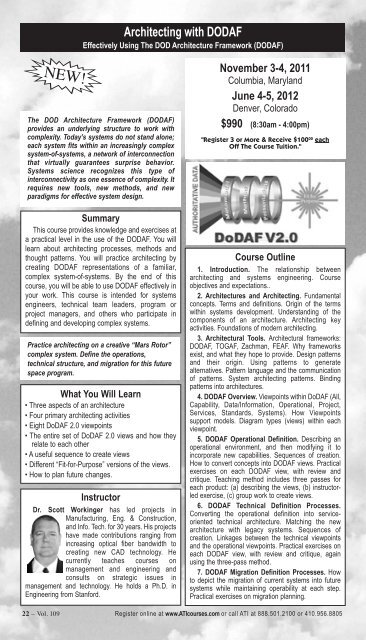Acoustics & Sonar Engineering Radar, Missiles & Defense Systems ...
Acoustics & Sonar Engineering Radar, Missiles & Defense Systems ...
Acoustics & Sonar Engineering Radar, Missiles & Defense Systems ...
You also want an ePaper? Increase the reach of your titles
YUMPU automatically turns print PDFs into web optimized ePapers that Google loves.
NEW!<br />
Architecting with DODAF<br />
Effectively Using The DOD Architecture Framework (DODAF)<br />
The DOD Architecture Framework (DODAF)<br />
provides an underlying structure to work with<br />
complexity. Today’s systems do not stand alone;<br />
each system fits within an increasingly complex<br />
system-of-systems, a network of interconnection<br />
that virtually guarantees surprise behavior.<br />
<strong>Systems</strong> science recognizes this type of<br />
interconnectivity as one essence of complexity. It<br />
requires new tools, new methods, and new<br />
paradigms for effective system design.<br />
Summary<br />
This course provides knowledge and exercises at<br />
a practical level in the use of the DODAF. You will<br />
learn about architecting processes, methods and<br />
thought patterns. You will practice architecting by<br />
creating DODAF representations of a familiar,<br />
complex system-of-systems. By the end of this<br />
course, you will be able to use DODAF effectively in<br />
your work. This course is intended for systems<br />
engineers, technical team leaders, program or<br />
project managers, and others who participate in<br />
defining and developing complex systems.<br />
Practice architecting on a creative “Mars Rotor”<br />
complex system. Define the operations,<br />
technical structure, and migration for this future<br />
space program.<br />
What You Will Learn<br />
• Three aspects of an architecture<br />
• Four primary architecting activities<br />
• Eight DoDAF 2.0 viewpoints<br />
• The entire set of DoDAF 2.0 views and how they<br />
relate to each other<br />
• A useful sequence to create views<br />
• Different “Fit-for-Purpose” versions of the views.<br />
• How to plan future changes.<br />
Instructor<br />
Dr. Scott Workinger has led projects in<br />
Manufacturing, Eng. & Construction,<br />
and Info. Tech. for 30 years. His projects<br />
have made contributions ranging from<br />
increasing optical fiber bandwidth to<br />
creating new CAD technology. He<br />
currently teaches courses on<br />
management and engineering and<br />
consults on strategic issues in<br />
management and technology. He holds a Ph.D. in<br />
<strong>Engineering</strong> from Stanford.<br />
November 3-4, 2011<br />
Columbia, Maryland<br />
June 4-5, 2012<br />
Denver, Colorado<br />
$990 (8:30am - 4:00pm)<br />
"Register 3 or More & Receive $100 00 each<br />
Off The Course Tuition."<br />
Course Outline<br />
1. Introduction. The relationship between<br />
architecting and systems engineering. Course<br />
objectives and expectations..<br />
2. Architectures and Architecting. Fundamental<br />
concepts. Terms and definitions. Origin of the terms<br />
within systems development. Understanding of the<br />
components of an architecture. Architecting key<br />
activities. Foundations of modern architecting.<br />
3. Architectural Tools. Architectural frameworks:<br />
DODAF, TOGAF, Zachman, FEAF. Why frameworks<br />
exist, and what they hope to provide. Design patterns<br />
and their origin. Using patterns to generate<br />
alternatives. Pattern language and the communication<br />
of patterns. System architecting patterns. Binding<br />
patterns into architectures.<br />
4. DODAF Overview. Viewpoints within DoDAF (All,<br />
Capability, Data/Information, Operational, Project,<br />
Services, Standards, <strong>Systems</strong>). How Viewpoints<br />
support models. Diagram types (views) within each<br />
viewpoint.<br />
5. DODAF Operational Definition. Describing an<br />
operational environment, and then modifying it to<br />
incorporate new capabilities. Sequences of creation.<br />
How to convert concepts into DODAF views. Practical<br />
exercises on each DODAF view, with review and<br />
critique. Teaching method includes three passes for<br />
each product: (a) describing the views, (b) instructorled<br />
exercise, (c) group work to create views.<br />
6. DODAF Technical Definition Processes.<br />
Converting the operational definition into serviceoriented<br />
technical architecture. Matching the new<br />
architecture with legacy systems. Sequences of<br />
creation. Linkages between the technical viewpoints<br />
and the operational viewpoints. Practical exercises on<br />
each DODAF view, with review and critique, again<br />
using the three-pass method.<br />
7. DODAF Migration Definition Processes. How<br />
to depict the migration of current systems into future<br />
systems while maintaining operability at each step.<br />
Practical exercises on migration planning.<br />
22 – Vol. 109 Register online at www.ATIcourses.com or call ATI at 888.501.2100 or 410.956.8805

















